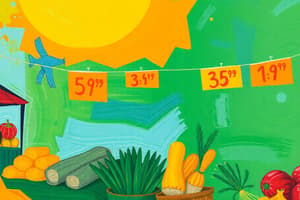Podcast
Questions and Answers
What was the legislation that Congress enacted to help farmers with federal price supports called?
What was the legislation that Congress enacted to help farmers with federal price supports called?
- Reconstruction Finance Corporation
- Hawley-Smoot Tariff Act
- Federal Home Loan Bank Act
- McNary-Haugen Bill (correct)
What is meant by buying goods on credit?
What is meant by buying goods on credit?
An arrangement to buy now and pay later, often in installments with interest charges.
Who was the Democratic candidate in the 1928 election?
Who was the Democratic candidate in the 1928 election?
Alfred E. Smith
What is the Dow Jones Industrial Average?
What is the Dow Jones Industrial Average?
Speculation in the stock market involves ignoring risks in hopes of a quick profit.
Speculation in the stock market involves ignoring risks in hopes of a quick profit.
What does 'buying on margin' mean?
What does 'buying on margin' mean?
What event is referred to as Black Tuesday?
What event is referred to as Black Tuesday?
What was the Great Depression?
What was the Great Depression?
What did the Hawley-Smoot Tariff Act aim to achieve?
What did the Hawley-Smoot Tariff Act aim to achieve?
What are shantytowns?
What are shantytowns?
What are soup kitchens?
What are soup kitchens?
What are bread lines?
What are bread lines?
What region was referred to as the Dust Bowl?
What region was referred to as the Dust Bowl?
What is meant by direct relief?
What is meant by direct relief?
Who was President during the stock market crash of October 1929?
Who was President during the stock market crash of October 1929?
What is the Boulder Dam also known as?
What is the Boulder Dam also known as?
What did the Federal Home Loan Bank Act do?
What did the Federal Home Loan Bank Act do?
What was the purpose of the Reconstruction Finance Corporation?
What was the purpose of the Reconstruction Finance Corporation?
What was the Bonus Army?
What was the Bonus Army?
Flashcards are hidden until you start studying
Study Notes
Price Support
- McNary-Haugen bill aimed to assist farmers through federal price supports for crucial crops like wheat, corn, cotton, and tobacco.
- The government intended to purchase surplus crops at guaranteed prices, subsequently selling them on the global market.
Credit
- Consumers often bought goods on credit, allowing them to obtain products immediately and pay later.
- This arrangement typically involved installment plans with monthly payments, including interest charges.
Alfred E. Smith
- The 1928 presidential election featured a contest between Republican Herbert Hoover and Democrat Alfred E. Smith.
- The election occurred amidst an illusion of national prosperity, despite looming economic disaster.
Dow Jones Industrial Average
- The Dow Jones Industrial Average serves as a primary indicator of the stock market's health.
- It reflects stock prices of 30 prominent firms listed on the New York Stock Exchange.
Speculation
- Speculation occurred when investors purchased stocks and bonds with expectations of quick profits while disregarding associated risks.
Buying on Margin
- Investors engaged in buying on margin, paying only a fraction of a stock's cost upfront and borrowing the remainder.
- The accessibility of easy money fueled rampant market trading, driving prices higher.
Black Tuesday
- October 29, known as Black Tuesday, marked a catastrophic day for the stock market, leading to widespread panic among shareholders.
- A record 16.4 million shares were dumped as investors rushed to sell before prices fell further.
Great Depression
- The stock market crash initiated the Great Depression (1929-1940), a period of severe economic decline and soaring unemployment.
- Though the crash accelerated the downturn, it was not the sole cause of the Great Depression.
Hawley-Smoot Tariff Act
- The 1930 Hawley-Smoot Tariff Act implemented the highest protective tariff in U.S. history to shield American farmers and manufacturers.
- The tariff inadvertently hindered foreign trade, decreasing foreign nations' ability to purchase U.S. goods.
Shantytown
- Numerous shantytowns emerged, consisting of makeshift huts constructed from scrap materials.
- Inhabitants often lived in dire conditions, using items like orange crates and discarded cars for shelter.
Soup Kitchen
- Soup kitchens provided free or low-cost meals to impoverished individuals, a necessary resource for many during hard times.
- Desperate individuals frequently rummaged through trash or begged for food.
Bread Lines
- Bread lines became common as individuals waited for food distributed by charitable organizations or government programs.
- These lines illustrated the widespread hunger and desperation across the nation.
Dust Bowl
- The Dust Bowl comprised areas in Kansas, Oklahoma, Texas, New Mexico, and Colorado, devastated by dust storms and agricultural failures.
- Thousands of displaced farmers and sharecroppers abandoned their land due to relentless environmental challenges.
Direct Relief
- Early in the Great Depression, the federal government lacked a direct relief system to provide cash or food assistance to the impoverished.
- Most relief efforts were conducted by local cities and charitable groups but offered limited support.
Herbert Hoover
- After the October 1929 stock market crash, President Hoover assured Americans that the economy was sound, urging optimism.
- He encouraged people to maintain their daily routines, despite the unfolding economic crisis.
Boulder Dam
- President Hoover approved the construction of Boulder Dam (later Hoover Dam) in late 1929.
- The dam became the tallest in the world and the second largest, providing electricity, flood control, and a regular water supply.
Federal Home Loan Bank Act
- The Federal Home Loan Bank Act, enacted in 1932, lowered mortgage rates for homeowners and allowed farmers to refinance loans.
- This act aimed to help avoid foreclosure during the economic downturn.
Reconstruction Finance Corporation
- The Reconstruction Finance Corporation, created in January 1932, enabled $2 billion for emergency funding for large businesses and financial institutions.
- Hoover believed this funding would stimulate job creation and wage increases for the average citizen.
Bonus Army
- In 1932, the Bonus Army, comprising between 10,000 to 20,000 World War I veterans and families, gathered in Washington D.C.
- They advocated for the Patman Bill, which proposed a bonus payment to veterans who had not been sufficiently compensated for their service.
Studying That Suits You
Use AI to generate personalized quizzes and flashcards to suit your learning preferences.




